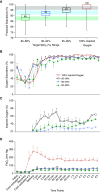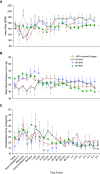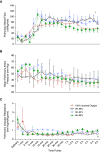Optimal Oxygen Targets in Term Lambs with Meconium Aspiration Syndrome and Pulmonary Hypertension
- PMID: 32609558
- PMCID: PMC7528912
- DOI: 10.1165/rcmb.2019-0449OC
Optimal Oxygen Targets in Term Lambs with Meconium Aspiration Syndrome and Pulmonary Hypertension
Abstract
Optimal oxygen saturation as measured by pulse oximetry (SpO2) in neonatal lung injury, such as meconium aspiration syndrome (MAS) and persistent pulmonary hypertension of newborn (PPHN), is not known. Our goal was to determine the SpO2 range in lambs with MAS and PPHN that results in the highest brain oxygen delivery (bDO2) and pulmonary blood flow (Qp) and the lowest pulmonary vascular resistance and oxidative stress. Meconium was instilled into endotracheal tubes in 25 near-term gestation lambs, and the umbilical cord was occluded to induce asphyxia and gasping, causing MAS and PPHN. Lambs were randomized into four groups and ventilated for 6 hours with fixed fraction of inspired oxygen (FiO2) = 1.0 irrespective of SpO2, and three groups had FiO2 titrated to keep preductal SpO2 between 85% and 89%, 90% and 94%, and 95% and 99%, respectively. Tissues were collected to measure nitric oxide synthase activity, 3-nitrotyrosine, and 8-isoprostanes. Throughout the 6-hour exposure period, lambs in the 95-99% SpO2 target group had the highest Qp, lowest pulmonary vascular resistance, and highest bDO2 but were exposed to higher FiO2 (0.5 ± 0.21 vs. 0.29 ± 0.17) with higher lung 3-nitrotyrosine (0.67 [interquartile range (IQR), 0.43-0.73] ng/mcg protein vs. 0.1 [IQR, 0.09-0.2] ng/mcg protein) and lower lung nitric oxide synthase activity (196 [IQR, 192-201] mMol nitrite/mg protein vs. 270 [IQR, 227-280] mMol nitrite/mg protein) compared with the 90-94% target group. Brain 3-nitrotyrosine was lower in the 85-89% target group, and brain/lung 8-isoprostane levels were not significantly different. In term lambs with MAS and PPHN, Qp and bDO2 through the first 6 hours are higher with target SpO2 in the 95-99% range. However, the 90-94% target range is associated with significantly lower FiO2 and lung oxidative stress. Clinical trials comparing the 90-94% versus the 95-99% SpO2 target range in term infants with PPHN are warranted.
Keywords: PPHN; lung injury; oxygen saturation.
Figures




Similar articles
-
Oxidant stress from uncoupled nitric oxide synthase impairs vasodilation in fetal lambs with persistent pulmonary hypertension.Am J Physiol Heart Circ Physiol. 2007 Apr;292(4):H1812-20. doi: 10.1152/ajpheart.00425.2006. Epub 2006 Dec 1. Am J Physiol Heart Circ Physiol. 2007. PMID: 17142346
-
Decreased endothelial nitric oxide synthase expression and function contribute to impaired mitochondrial biogenesis and oxidative stress in fetal lambs with persistent pulmonary hypertension.Am J Physiol Lung Cell Mol Physiol. 2016 Jan 1;310(1):L40-9. doi: 10.1152/ajplung.00392.2014. Epub 2015 Oct 30. Am J Physiol Lung Cell Mol Physiol. 2016. PMID: 26519208 Free PMC article.
-
Apocynin improves oxygenation and increases eNOS in persistent pulmonary hypertension of the newborn.Am J Physiol Lung Cell Mol Physiol. 2012 Mar 15;302(6):L616-26. doi: 10.1152/ajplung.00064.2011. Epub 2011 Dec 23. Am J Physiol Lung Cell Mol Physiol. 2012. PMID: 22198908 Free PMC article.
-
Optimal oxygenation and role of free radicals in PPHN.Free Radic Biol Med. 2019 Oct;142:97-106. doi: 10.1016/j.freeradbiomed.2019.04.001. Epub 2019 Apr 14. Free Radic Biol Med. 2019. PMID: 30995536 Free PMC article. Review.
-
Pulmonary hypertension and oxidative stress: Where is the link?Semin Fetal Neonatal Med. 2022 Aug;27(4):101347. doi: 10.1016/j.siny.2022.101347. Epub 2022 Apr 19. Semin Fetal Neonatal Med. 2022. PMID: 35473693 Free PMC article. Review.
Cited by
-
Oxygen Saturation Targeting in the Neonatal Intensive Care Unit.J Clin Med. 2025 Jun 4;14(11):3975. doi: 10.3390/jcm14113975. J Clin Med. 2025. PMID: 40507737 Free PMC article. Review.
-
Supplemental Oxygen in the Newborn: Historical Perspective and Current Trends.Antioxidants (Basel). 2021 Nov 25;10(12):1879. doi: 10.3390/antiox10121879. Antioxidants (Basel). 2021. PMID: 34942982 Free PMC article. Review.
-
Vitality in Newborn Farm Animals: Adverse Factors, Physiological Responses, Pharmacological Therapies, and Physical Methods to Increase Neonate Vigor.Animals (Basel). 2023 May 4;13(9):1542. doi: 10.3390/ani13091542. Animals (Basel). 2023. PMID: 37174579 Free PMC article. Review.
-
Oxygen Targets in Neonatal Pulmonary Hypertension: Individualized, "Precision-Medicine" Approach.Clin Perinatol. 2024 Mar;51(1):77-94. doi: 10.1016/j.clp.2023.12.003. Epub 2023 Dec 28. Clin Perinatol. 2024. PMID: 38325948 Free PMC article. Review.
-
How Do We Monitor Oxygenation during the Management of PPHN? Alveolar, Arterial, Mixed Venous Oxygen Tension or Peripheral Saturation?Children (Basel). 2020 Oct 13;7(10):180. doi: 10.3390/children7100180. Children (Basel). 2020. PMID: 33066076 Free PMC article. Review.
References
-
- Weiner GM, Zaichkin J, editors. Textbook of Neonatal Resuscitation (NRP) 7th ed. Elk Grove Village, IL: American Academy of Pediatrics; 2016.
-
- Nakwan N, Chaiwiriyawong P. An international survey on persistent pulmonary hypertension of the newborn: a need for an evidence-based management. J Neonatal Perinatal Med. 2016;9:243–250. - PubMed
-
- Hansmann G, Koestenberger M, Alastalo TP, Apitz C, Austin ED, Bonnet D, et al. 2019 updated consensus statement on the diagnosis and treatment of pediatric pulmonary hypertension: the European Pediatric Pulmonary Vascular Disease Network (EPPVDN), endorsed by AEPC, ESPR and ISHLT. J Heart Lung Transplant. 2019;38:879–901. - PubMed

